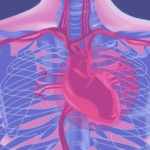Hirschsprung’s disease is a disorder marked by large intestinal abnormalities that lead to difficulties in bowel movements. It is a congenital condition and is caused due to lack of nerve cells in the muscles of some part or all parts of the colon of a newborn. The condition may also be detected later in life, but it is often less severe. Hirschsprung’s disease in adults is very rare.
In most cases, doctors will diagnose a case of Hirschsprung’s disease in newborns if the baby is unable to pass stools even after a few days have passed post-delivery.Treatment involves surgery that can remove or bypass the affected section of the colon.
Symptoms of Hirschsprung’s disease
The symptoms of Hirschsprung’s disease are dependent on the severity of the disorder. The signs typically occur just after birth, but it is also possible for patients to experience them at a later stage in life.
In most cases, the most noticeable symptom of the condition is lack of bowel movements in babies with a period of 48 hours post birth. Additional symptoms are listed below:
- Vomiting; sometimes brown or green matter may be present in the vomit.
- Swollen abdomen or belly
- Gas or constipation. This can cause the baby to become irritable or fussy
- Diarrhea
The symptoms of Hirschsprung’s disease in older children and/or adults may include:
- Chronic constipation
- Swollen abdomen
- Lack of any weight gain
- Gas
- Exhaustion or fatigue
Children with Hirschsprung’s disease are at increased risk to developing a serious medical complication called enterocolitis. It is an infection of the colon that occurs due to overgrowth of bacteria in the affected part of the colon. Stool tends to get accumulated in the affected colon segment, which then exerts pressure on the blood vessels of the wall thereby causing them to rupture and result in infection. Patients need to be hospitalized. Enterocolitis is treated with antibiotics and colon cleaning.
Causes
Doctors are not aware about the precise cause of Hirschsprung’s disease. It is thought to be linked to some gene mutation or may run in families.
Hirschsprung’s disease develops due to incomplete formation of the nerve cells in the muscles of the colon. These nerve cells are vital to proper functioning of the colon. They control and facilitate muscle contractions on a regular basis and thus aid the process of constant movement of food across the bowels.
When the fetus is developing in the womb, the ganglia or nerve cell bundles start developing between the layers of muscles across the colon’s length. This process commences at the top end of the colon and finishes at the rectum. In newborn, children, and adult patients this process of nerve growth does not finish fully.In most cases, the nerve cells do not form in the last section of the colon, i.e., the sigmoid colon and the rectum. In some cases, lack of nerve cells development may affect the entire large intestine and even some section of the small bowel.
Some of the risk factors which can increase the susceptibility of the occurrence of Hirschsprung’s disease in newborns, children, or adults are listed below:
- Males are more prone to the disease than females
- The condition can he inherited. Thus, if one child has the disease, then the possibility of the next child being born with Hirschsprung’s disease is increased.
- Hirschsprung’s disease is known to have links with other genetic conditions like Down syndrome, inherited cardiac issues, thyroid gland cancer, and multiple endocrine neoplasia type IIB, etc. Thus, presence of these genetic disorders increases the vulnerability to developing Hirschsprung’s disease.
Treatment of Hirschsprung’s disease
Hirschsprung’s disease is treated by surgical procedures that either bypass the affected part of the colon or remove the entire affected segment.
In surgical bypass, the lining of the section of colon with nil nerve cells is stripped out and the normal part of the colon is pulled across the large bowel from within and later joined to the anus. This surgical procedure is performed via the anus with laparoscopic minimally invasive methods.
Surgery in affected children who are ill can be carried out in the following two steps:
- The colon segment without nerve cells is removed. Then the healthy part of the colon is attached to an ostomy, or a tiny hole, that the surgeon will make in the abdomen. The stool will pass out through this hole into a bag, which is connected to the healthy colon’s end that is surgically placed at the ostomy. The lower segment of the colon is then allowed to heal.Ostomy can be carried out as a colostomy or an ileostomy.
- Upon healing, the ostomy is closed by the surgeon and the healthy section of the colon is connected to the anus or rectum.
The doctor will monitor for any side effects of surgery. He/she will also suggest diet changes, exercising, and use of laxatives to help relieve constipation and enhance bowel movements.
